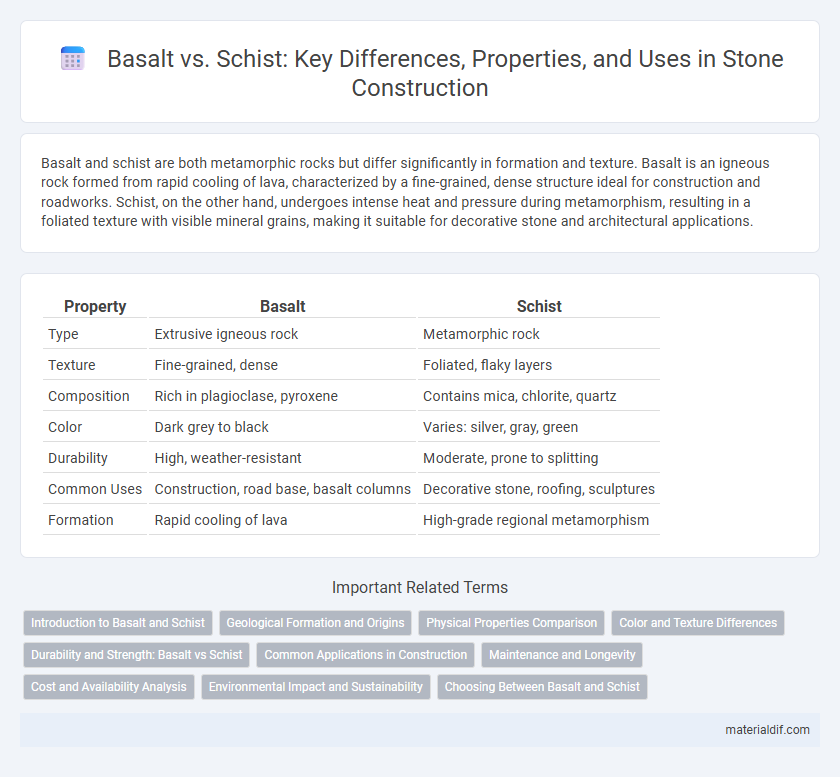Basalt and schist are both metamorphic rocks but differ significantly in formation and texture. Basalt is an igneous rock formed from rapid cooling of lava, characterized by a fine-grained, dense structure ideal for construction and roadworks. Schist, on the other hand, undergoes intense heat and pressure during metamorphism, resulting in a foliated texture with visible mineral grains, making it suitable for decorative stone and architectural applications.
Table of Comparison
| Property | Basalt | Schist |
|---|---|---|
| Type | Extrusive igneous rock | Metamorphic rock |
| Texture | Fine-grained, dense | Foliated, flaky layers |
| Composition | Rich in plagioclase, pyroxene | Contains mica, chlorite, quartz |
| Color | Dark grey to black | Varies: silver, gray, green |
| Durability | High, weather-resistant | Moderate, prone to splitting |
| Common Uses | Construction, road base, basalt columns | Decorative stone, roofing, sculptures |
| Formation | Rapid cooling of lava | High-grade regional metamorphism |
Introduction to Basalt and Schist
Basalt is a dense, fine-grained igneous rock formed from rapid cooling of lava at the Earth's surface, characterized by its dark color and high iron and magnesium content. Schist is a medium to coarse-grained metamorphic rock known for its pronounced foliation, resulting from intense heat and pressure that realign its mineral grains, often containing abundant mica. Basalt's volcanic origin contrasts with schist's metamorphic transformation, making their textures and mineral compositions distinct in geological studies.
Geological Formation and Origins
Basalt forms through the rapid cooling of low-viscosity lava at or near Earth's surface, primarily composed of fine-grained mafic minerals rich in iron and magnesium. Schist originates from the regional metamorphism of shale or mudstone, undergoing intense heat and pressure that realign its platy minerals into a foliated texture dominated by mica and chlorite. The igneous formation of basalt contrasts with the metamorphic genesis of schist, highlighting their distinct geological origins and mineral compositions.
Physical Properties Comparison
Basalt is a dense, fine-grained igneous rock with high compressive strength and low porosity, making it highly durable and resistant to weathering. Schist, a foliated metamorphic rock, exhibits pronounced foliation and a flaky texture due to aligned mica crystals, resulting in lower mechanical strength and higher permeability compared to basalt. The contrasting physical properties influence their suitability for construction and landscaping, with basalt preferred for high-strength applications and schist favored for decorative uses.
Color and Texture Differences
Basalt typically exhibits a dark gray to black color with a fine-grained, dense texture due to rapid cooling of lava. Schist displays a variety of colors, including gray, green, or reddish hues, characterized by its foliated texture with visible mineral grains aligned in layers. The color contrast and textural differences between basalt's uniform, compact surface and schist's layered, shimmering appearance aid in distinguishing these igneous and metamorphic rocks.
Durability and Strength: Basalt vs Schist
Basalt exhibits higher durability and strength compared to schist due to its dense, fine-grained volcanic origin, making it resistant to weathering and mechanical stress. Schist, characterized by its foliated texture and mineral layering, tends to be less durable and more prone to splitting under pressure. For construction and high-stress applications, basalt is generally preferred over schist for its superior load-bearing capacity and longevity.
Common Applications in Construction
Basalt is widely used in construction for its durability and strength, commonly found in road base materials, concrete aggregates, and dimension stone for building facades. Schist is favored for decorative purposes due to its attractive foliated texture, often used in wall cladding, roofing tiles, and landscaping features. Both stones provide unique aesthetic and functional benefits, with basalt offering structural integrity and schist contributing natural beauty to construction projects.
Maintenance and Longevity
Basalt offers exceptional durability and low maintenance due to its fine-grained, dense structure that resists weathering and erosion, making it ideal for high-traffic or outdoor applications. Schist, characterized by its foliated texture, requires more frequent sealing and care to prevent delamination and moisture damage, impacting its long-term longevity especially in harsh environments. Choosing basalt ensures prolonged structural integrity with minimal upkeep, while schist demands attentive maintenance to preserve its aesthetic and physical properties over time.
Cost and Availability Analysis
Basalt is generally more affordable than schist due to its widespread availability and easier quarrying processes, making it a cost-effective option for construction and landscaping projects. Schist, while valued for its unique foliated texture and aesthetic appeal, tends to be more expensive because it is less abundant and often requires more specialized extraction and finishing techniques. The availability of basalt in vast volcanic regions contributes to lower transportation costs, whereas schist's limited geographic deposits can drive up overall expenses.
Environmental Impact and Sustainability
Basalt, formed from cooled lava, has a lower environmental impact due to its abundant availability and durability, reducing the need for frequent replacement in construction. Schist, a metamorphic rock, often requires significant quarrying and processing, leading to higher energy consumption and habitat disruption. Sustainable use of basalt supports eco-friendly building practices by minimizing resource extraction and promoting long-lasting material performance.
Choosing Between Basalt and Schist
Basalt offers exceptional durability and a dense, fine-grained structure ideal for heavy-duty construction and outdoor applications. Schist features a distinctive foliated texture with visible mineral grains, making it a preferred choice for decorative stonework and landscaping. Selecting between basalt and schist depends on whether strength and weather resistance or aesthetic appeal and texture are prioritized.
Basalt vs Schist Infographic

 materialdif.com
materialdif.com